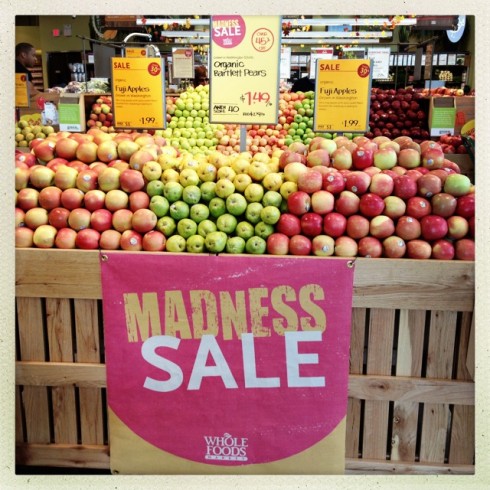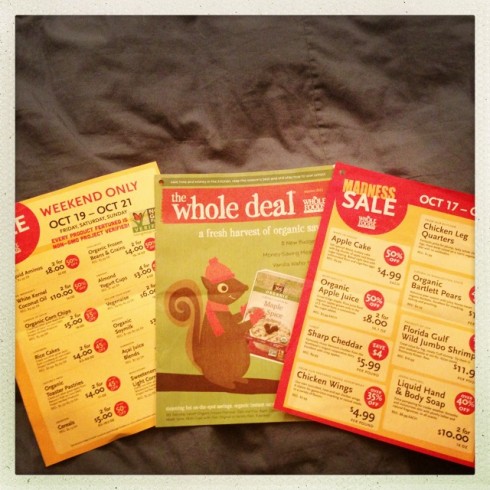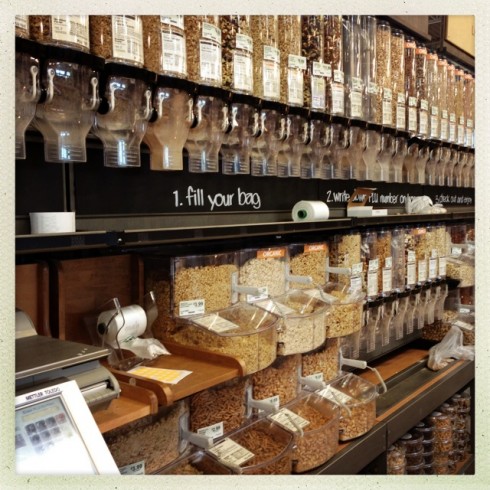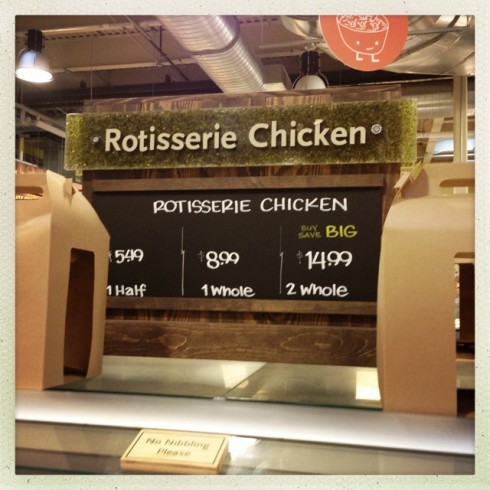Whole Foods for $100: 10 Ways To Save at Whole Foods Market {Naptime Simple Tips}
Last week I revealed a little bit about on my recent collaboration with Whole Foods Market. In mid-October, pre-Sandy, I spent one whole week feeding my family exclusively from Whole Foods on a strict budget of $100. It was not easy considering the “whole paycheck” reputation of Whole Foods Market but I found it surprisingly doable. One of the keys to the challenge was changing my Whole Foods Market shopping habits. I’ll admit, I’ve never been a super-strategic shopper at Whole Foods Market. I was surprised at how much money I could save when I actually applied myself to learning the signage and zeroing in on a set meal plan. Today I am going to share my new favorite tips for shopping Whole Foods Market and tomorrow I will share the menu we enjoyed for the week.
One of the helpful advantages I was given when I started this project was a tour of our local Whole Foods Market with the manager, Christen. Hopefully I can outline what I learned below so you are able to glean ways to save at your local store. Christen opened my eyes to all of the terrific ways to save at Whole Foods Market each and every day. Many of which, I was a little surprised to learn, have been right under my nose the whole time. After chatting with Christen I knew it was time to strategize in order to fit my budget constraints for the challenge. Instead of walking into the store with my menu and buying ingredients no matter the cost (within reason), for this challenge I devised our week of meals around the deals I found.
Within the first five minutes of our discussion I voiced my desire for a Whole Foods Market frequent shopper card or at least coupon books and Christen led my straight over to the Whole Deal. I’ll confess, I always thought that leaflet was a coloring book for kids or an information packet full of calorie counts and organic food facts. But then I learned it is full of COUPONS!! Wha?? And not only coupons, but coupons for everyday normal items like organic 365 brand cereals, organic yogurts (the kind I like!), and healthy staples for my pantry. Also, Christen mentioned that if I wasn’t at the store to get the booklet I could always print out coupons from the Whole Deal online. I was stunned. Why didn’t I know this before? The Whole Deal is such a practical and easy way to cut costs at Whole Foods Market before you even step in the store.
Moving on, Christen pulled two more sheets from the discount stand and introduced me to the Weekly Madness Sales. These are weekly sales on all organic foods from their store. The sales are major and focus on seasonal organic items as well as practical everyday favorites. For example, this particular week there were sales on squash, broccoli, and pears. All are seasonal, local fruits and vegetables and they were steeply discounted to encourage customers to dig in to the healthy foods.
Finally, in addition to the Whole Deal and the Madness Sales, various foods throughout the store are marked with red dots to indicate they are Everyday Deals. These are the deals that are not immediately dependent on the season and you can count on every time you enter the store. For example, I am always be able to find the two rotisserie chicken for $14.99 at my store year-round. They also have an everyday lunch deal for a sandwich, drink, and chips for $7.99, and as well as everyday deals on popular fruits and vegetables. Brand-based deals are often found indicated with tabs beneath the food in the dry good section.
Before I devised our weekly menu I researched the Whole Deal as well as the Madness Sales for the week I was shopping. It made so much sense to look for the discounts before going to the store instead of stumbling upon them. I also knew to keep my eye out for the red dot Everyday Deal signage.
Here are a few more excellent tips Christen gave me for saving money everyday at Whole Foods Market:
1) Ends of the Aisles: In most stores discounted items are set up on displays at the ends of the aisles. For example, the week I was there cans of pumpkin were stacked at the end of the aisles along with pasta sauce, pumpkin ale, soup stocks, and dried pastas. All healthy staples for solid family meals at rock bottom prices.
2) Shop the Bulk Section: Our Whole Foods Market has a large selection of bulk grains, flours, rices, granola, salts, nuts, and more. When you shop the bulk aisle you only have to buy as much as you need and you aren’t paying for a particular brand or packaging. This can be a huge money saver when you are shopping for a big family. (Hint: I got some of our favorite snack foods here!)
3) Discount Dry Goods Towers & Freezer Bins: Located in front of the fish counter and the meat counter are freezer bins of meats and fish. They are simple cuts of meat and fish that have been freeze-packed and steeply discounted. Some are even packed in simple marinades which makes them easy to take home and prepare as you wish. The discount towers for dry goods are usually for products sold by the case such as Hint Mint water or giant bags of Pirate’s Booty. These are helpful discounts when you are stocking up on snack food or preparing for a large gathering.
4) Make Your Own: Our Whole Foods Market has a make your own nut butters section which is simple to use and fascinating for kids. You can literally pick out as many nuts as you want and watch the machine grind them up and spit the butter into a jar for you to take home. Not only is this exceptionally healthy, it is also a good way to save because you aren’t paying for any expensive brand packaging.
5) Produce Savings: The produce section can get pricey quickly. To save money it makes sense to buy things like root vegetables, garlic, onions, carrots, celery, lemons, and limes in bulk. (Selection may change from store to store). The bulk vegetables are found in large net bags toward the back of the section. If you’d rather not buy in bulk check if the vegetables you desire are in the pre-cut vegetable section. For example, instead of buying onions, carrots, and celery to make a mirepoix you can can often find a container for pre-cut mirepoix that costs less than the vegetable individually and is the exact amount that you need.
6) Bring Your Own Bags: If you bring your own bags Whole Foods Market will give you 10-cents back per bag on your receipt. It is a small savings that adds up and is good for the environment.
7) 365 Everyday Value Food Brand: This brand is Whole Foods Markets in-house food line. Whenever you see this label you can be guaranteed that it is top quality food at the best possible prices. Buying 365 Everyday Value makes it easy to buy high-quality food staples at reasonable prices.
These awesome saving tips were just the things I needed to get me started on my question to save money at Whole Foods Market and feed my family for one whole week on a budget of $100. Despite all of these excellent saving tips it still wasn’t easy to make the budget work, but we did and it was fantastic. Between learning about all these ways to save at Whole Foods Market and challenging us to eat on a strict budget I’ve developed a whole new appreciation for ways to save and enjoy one of my favorite grocery stores. Stay tuned tomorrow when I share the menu I served and serve up an awesome Whole Foods Market grocery giveaway!





[…] October 2012 Cape Cod Organic Gardeners NewsletterIs organic food betterAll-natural Natural Food Is Not For EveryoneNatural vs. Organic vs. Sustainable Foods (And Why You Should Choose “All Of The Above”)Should I Really Buy OrganicOrganic Food LawsWhole Foods for $100: 10 Ways To Save at Whole Foods Market […]
[…] Feeding my family from Whole Foods Market for $100 a week was not easy but we managed to do it. After my tour of our local store I learned all the ways to save while shopping and devised a menu plan to fit the deals that were available that week. I also had to make a few assumptions in order to make the budget work. I did not buy basic staples like olive oil, salt, pepper, basic spices, and flour since we already had them on hand. I generally don’t shop for them weekly anyway. I did not include lots of beverages in our budget since we usually drink water, iced tea (made from scratch), milk, and hot tea. My daughter does not like juice therefore I rarely, if ever, buy it. Finally, my husband eats his lunches at work and was on a business trip one night so I did not include his meal costs on the nights he didn’t eat with us. […]
Congrats! The whole paycheck theory is old hat now, if you stay on track with the 365 items then it’s no biggie 🙂
… [Trackback]…
[…] Informations on that Topic: thenaptimechef.com/2012/11/whole-foods-for-100-10-ways-to-save-at-whole-foods-market-naptime-simple-tips/ […]…
.
Hi, nice article i shop every week @ whole food but end up with $150 + .
I tried to buy what i need. In the begining i used to buy $50 worth of grocery but now after shopping for groceries since last couple of years i buy almost 90% of my grocery from whole food.
I compare other grocery store pricing with wf and i dont see much difference in the pricing.
i think we get good quality food from wf even organic or non organice A+ quality.
I like the tips and i think if you do ur homework before shopping you can save money and get healthy food
Those prices are still expensive… At a normal grocery store you can get 2 chickens for $8 and apples for 99c per pound in season